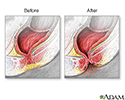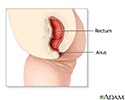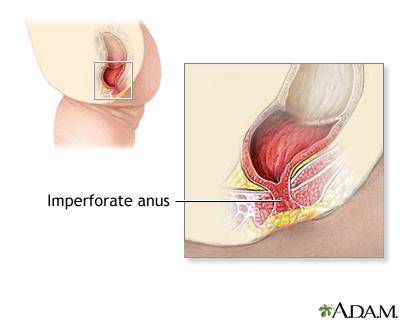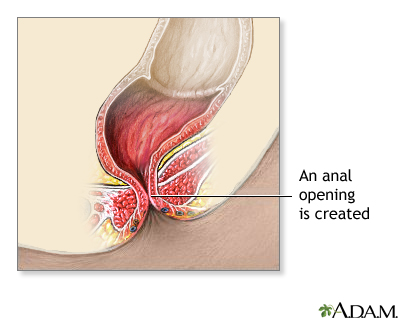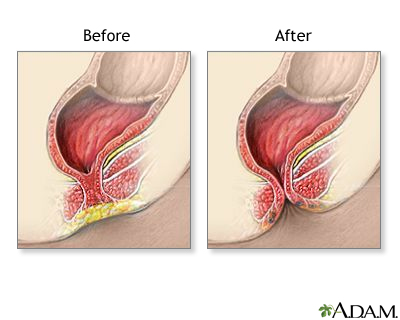Imperforate anus
Anorectal malformation; Anal atresia
Imperforate anus is a defect that is present from birth (congenital). The opening to the anus is missing or blocked. The anus is the opening to the rectum through which stools leave the body.
Causes
Imperforate anus may occur in several forms.
- The rectum may end in a pouch that does not connect with the colon.
- The rectum may have openings to other structures. These may include the urethra, bladder, base of the penis or scrotum in boys, or vagina in girls.
- There may be narrowing (stenosis) of the anus or no anus.
It is caused by abnormal development of the fetus. Many forms of imperforate anus occur with other birth defects.
Symptoms
Symptoms of the problem may include:
- Anal opening very near the vagina opening in girls
- First stool is not passed within 24 to 48 hours after birth
- Missing or moved opening to the anus
- Stool passes out of the vagina, base of penis, scrotum, or urethra
- Swollen belly area
Exams and tests
A health care provider can diagnose this condition during a physical exam. Imaging tests may be recommended.
Treatment
The infant should be checked for other problems, such as abnormalities of the genitals, urinary tract, and spine.
Surgery to correct the defect is needed. If the rectum connects with other organs, these organs will also need to be repaired. A temporary colostomy (connecting the end of the large intestine to the abdomen wall so that stool can be collected in a bag) is often needed.
Outlook (prognosis)
Most defects can successfully be corrected with surgery. Most children with mild defects do very well. However, constipation can be a problem.
Children who have more complex surgeries still have control over their bowel movements most of the time. However, they often need to follow a bowel program. This includes eating high-fiber foods, taking stool softeners, and sometimes using enemas.
Some children may need more surgery.
When to Contact a Medical Professional
This problem is often found when the newborn infant is first examined. Call your provider if a child treated for imperforate anus has abdominal pain or fails to develop any bowel control by the age of 3.
Prevention
There is no known prevention. Parents with a family history of this defect may seek genetic counseling.
References
Chung DH. Pediatric surgery. In: Townsend CM Jr, Beauchamp RD, Evers BM, Mattox KL, eds. Sabiston Textbook of Surgery . 19th ed. Philadelphia, PA: Elsevier Saunders; 2012:chap 67.
Stafford SJ, Klein MD. Surgical conditions of the anus and rectum. In: Kliegman RM, Behrman RE, Jenson HB, Stanton BF, eds. Nelson Textbook of Pediatrics . 19th ed. Philadelphia, PA: Elsevier Saunders; 2011:chap 336.
-
Imperforate anus - illustration
Imperforate anus is a malformation of the anorectal region that may occur in several forms. The rectum may end in a blind pouch that does not connect with the colon, or it may have openings to the urethra, bladder, or vagina. A condition of stenosis, or narrowing of the anus, or absence of the anus may be present.
Imperforate anus
illustration
-
Imperforate anus repair - series
Presentation
-
Imperforate anus - illustration
Imperforate anus is a malformation of the anorectal region that may occur in several forms. The rectum may end in a blind pouch that does not connect with the colon, or it may have openings to the urethra, bladder, or vagina. A condition of stenosis, or narrowing of the anus, or absence of the anus may be present.
Imperforate anus
illustration
-
Imperforate anus repair - series
Presentation
Review Date: 4/21/2015
Reviewed By: Neil K. Kaneshiro, MD, MHA, Clinical Assistant Professor of Pediatrics, University of Washington School of Medicine, Seattle, WA. Also reviewed by David Zieve, MD, MHA, Isla Ogilvie, PhD, and the A.D.A.M. Editorial team.

